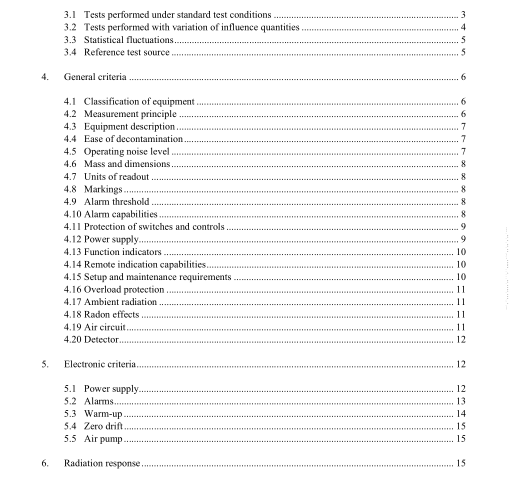IEEE N42.30-2002 pdf download.American National Standard for Performance Specification for Tritium Monitors
3.4 Reference test source Tests should be performed with tritium, although equivalent gamma ( 137 Cs preferred) fields or electrical simulation can be used for responses that require relatively high activities. More than one reference activity will be required in order to cover the complete effective range of the moni- tor. The relative (gamma or current) activities used shall be such that an appropriate radiation response is obtained in each range (for linear-scaled monitors) or each decade (for logarithmic-scaled monitors).
4. General criteria
4.1 Classification of equipment Various tritium monitor designs are available with many monitors being of a special design to meet the spe- cific needs of the user. This standard classifies tritium monitors based on the following operational and usage requirements; primary power source, system interface (output), and measurement range:
— Low-range tritium monitors include monitors that have a range, R, of 0 < R ≤ 1000 µCi/m 3 (µBq/m 3 ) .
— High-range monitors have a range of 0 < R ≤ X, where X is the maximum response of the monitor as stated by the manufacturer. — Installed tritium monitors typically have outputs that interface the monitor with a centralized radia- tion monitoring system to initiate alarms or indicate operating faults. Installed monitors operate using line power primarily and may have battery backup.
— Portable monitors could also have the ability to interface with a centralized system, but use battery power primarily. They can also use line power through an internal or external converter and are typ- ically carried from location to location for use.
4.1.1 Effective range of measurement
4.1.1.1 Discussion It is well known that measurements obtained from low levels of radiation are random. The randomness is primarily caused by the radiation level as well as a monitor’s ability to collect enough information within an acceptable time interval. The manufacturer is required to state the overall response range of the monitor. It should be from the lowest to highest displayed reading. Unfortunately, this response range is typically not possible with radiation-measuring devices. The point at which the monitor’s response becomes more ran- dom than what is acceptable is effectively the lowest response or the lowest point of the effective range of measurement. This point can also be loosely called minimum detectable activity (MDA). At this point, it would be difficult to discern between the randomness of the ambient radiation and an actual increase in activity. See 6.3 for information about how to determine the MDA for tritium monitors.
4.1.1.2 Requirements For analog meters, the effective range of measurement should be from 10% of the maximum reading of the lowest range or decade to 100% of the monitor’s stated response range. For digitally scaled assemblies, the effective range should be from the start of the second least significant digit (LSD) to the full range of indication available [i.e., if the stated response range was 0 to 1000 µCi/m 3 (µBq/m 3 ) , the effective range of measurement is 2 µCi/m 3 (µBq/m 3 ) to 1000 µCi/m 3 (µBq/m 3 ) ]
4.2 Measurement principle A wide range of measuring techniques are available for measuring tritium-in-air levels. These techniques include flow-through ionization chambers and gas-flow proportional counters with a range of compensation techniques for minimizing the response to background gamma radiation or other radioactive gas. Inlet filters should be incorporated to minimize the response to radioactivity from aerosols or particulates present. Water vapor traps may be used either to eliminate tritiated water vapor prior to the detector assembly (in equipment measuring tritiated water vapor selectively by difference techniques) or to concentrate the tritium in a medium that is subsequently passed through a detector assembly. The choice of technique in any particular situation will be influenced by the particular circumstances at the facility concerned.
4.3 Equipment description Tritium monitor components may be grouped into two assemblies, which may be associated or separated according to the monitoring and operating requirements. These two assemblies are the sampling and detec- tion assembly and the control and measurement assembly.IEEE N42.30 pdf download.IEEE N42.30-2002 pdf download
IEEE N42.30-2002 pdf download

Leave a Reply